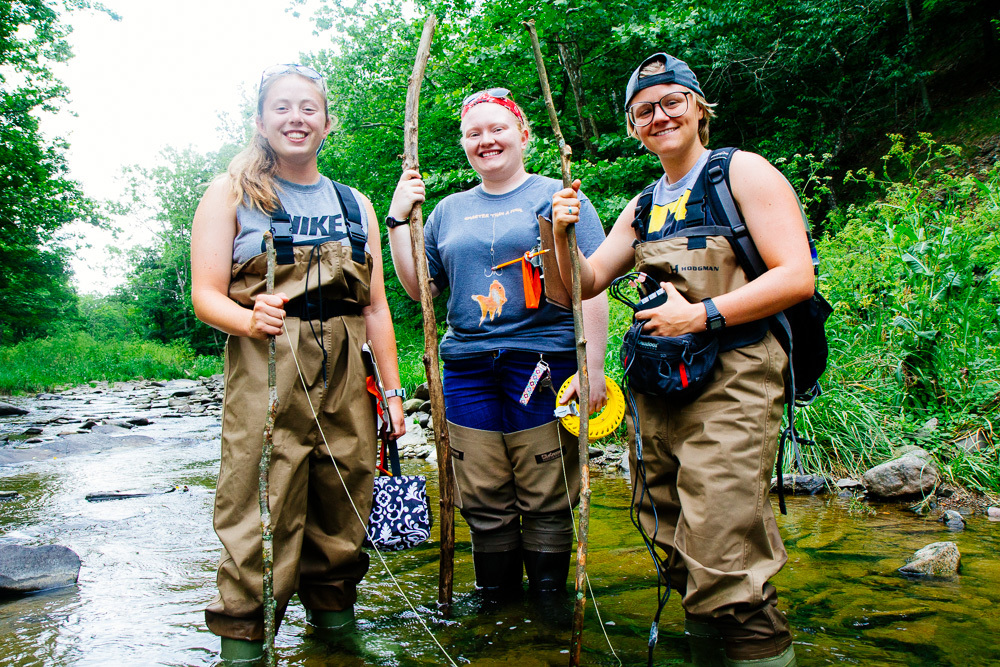Building on water quality research of three Eastern Mennonite University (EMU) professors, recent graduate Hannah Daley and senior Amanda Williams concluded a summer of data collection in the Bergton area watershed. With funding from the first EMU Summer Research Grant, the partners are investigating the relationship between canopy cover and stream water temperature in two headwater streams.
“One goal of the Daniel B. Suter Endowment Fund is to encourage student research,” said Stephen Cessna, a biochemistry professor who holds the Daniel B. Suter Endowed Chair at EMU. “This annual competitive summer research fellowship helps our biology and chemistry students build the key skills of scientific inquiry from writing the proposal to presenting and potentially publishing their findings.”

The research project meant long days in hip waders, carrying measuring tapes and other instruments through the rock-strewn bottoms of Crab Run and the German River. They were joined on some days by Bergton native Bekah Mongold, a junior biology major.
The field work was “exciting and exhausting,” says Williams. “I love being in nature, so it is kind of like a dream come true for me to be out in the field doing research that is both helping our understanding of how percent canopy coverage affects water temperature while also adding to the larger ongoing project that has been collecting stream restoration data for many years.”
Besides the research, Daley said she enjoyed getting to know the local residents. “My favorite part of traveling to Bergton was having lunch with Marge Peevy on her porch.”
Gathering internships and fieldwork experience
Both scientists are veteran researchers, with experience in the prestigious Research Experience for Undergraduates (REU) program. Additionally, Daley and Williams spent one-semester internships while at Washington Community Scholars’ Center with a NOAA-NASA contractor and at the National Museum of Natural History Botany Department, respectively. And both had worked extensively during their time at EMU on water quality projects with professors Doug Graber-Neufeld, Tara Kishbaugh and Jim Yoder.

The summer research grant offered the unique opportunity to create their own research proposal, Daley says. “After conducting the research, I can now recognized aspects of the project I should have considered in advance. One oversight was neglecting to note the peak bloom period for sycamore trees, the dominant tree species along the stream. They needed to be in full bloom to collect accurate canopy coverage data.”
The oversight pushed their anticipated May completion date into mid-September.
Long-term research in the Bergton watershed
Their results will contribute to several other EMU-sponsored stream restoration and research projects in the area that began in 2011. The previous year, local concern about area water resources increased, sparked by commercial interest in the potential development of a fracking site. Though the application was later denied by Rockingham County, area residents became active supporters of water quality research. The watershed, which had received notable damage through flooding in the past, is an important resource for homes and local agricultural, as well as area recreation.
A two-year interdisciplinary project started in 2014, with initial funding provided by a grant from the National Fish and Wildlife Foundation in collaboration with EMU’s Center for Justice and Peacebuilding, Ecosystem Services LLC, Smithsonian Conservation Biology Institute, and the Shenandoah Valley Soil and Water Conservation District. [Read more here.]

With the help of more than 15 students over the course of several years, various baseline data has been collected including temperature, pH, total dissolved solids, barium and strontium metal concentrations, macroinvertebrate and indicator species sampling.
Stream health important to diversity
Daley and Williams were most interested in how upstream canopy cover on Crab Run and the German River may influence temperature fluctuations downstream. While data analysis has not concluded, they suspect that farmed areas, which are cleared of creek- and river-side foliage, would have higher temperatures because of the high level of sunlight exposure. The water under and downstream of wooded areas, conversely, would have cooler temperatures.
“Water temperature has great implications for the biota that live within the stream,” said Williams, who did a similar study in Bethany Beach canals for her 2016 summer REU project. She says that certain species of macroinvertebrates and fish can only survive in certain temperatures and if the water gets too warm, some fish cannot even live in it, because there will be little to no dissolved oxygen to breathe.
Data analysis for the project concludes this month. The partners plan to share their conclusions at an upcoming conference and with the EMU community.
After graduating in spring 2018, Williams will go to graduate school —recently the field of astrobiology has caught her attention — and then continue to pursue research.

Daley plans to earn a doctorate in chemistry with a focus on atmospheric chemistry. While working as an admissions counselor at EMU this year, she’s also co-authoring a paper based on research from her 2015 REU on effects of caffeine on athletic performance.
Read about more EMU student internship experiences in the sciences:
- Hannah’s 2015 REU at James Madison University;
- the summer 2016 REU experiences of Hannah, Amanda and two other EMU students;
- Washington Community Scholars’ Center science-related internships in general;
- and Amanda’s internship at the Smithsonian Institute Museum of Natural History.
- Also check out this feature on Cerrie Mendoza’s summer 2017 field biology work with funded by the Smithsonian’s Global Genome Initiative.
